Issues related to solid waste management in Sri Lanka
Prof. Niranjanie RATNAYAKE
‘Waste’ as we all know, is what we have no use for – maybe we have
used it and it is not suitable for further use, or the useful material
came with some useless material that has to be discarded, or perhaps we
have an excess supply that we cannot use, or return to the supplier, and
therefore has to be thrown away. Anyway, we throw them away because we
feel that we have no further use for them.
|
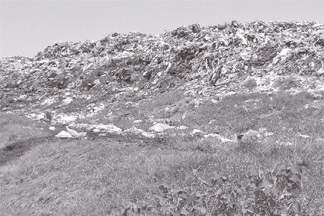
There are many reasons for the enormous increase in
waste quantities |
Many things have changed in the world within the last 50 years or so.
In the 60’s and 70’s, USA was called ‘the throwaway society’, while our
lifestyles were much more sustainable. We wore cotton clothes (which
were biodegradable), and our eating habits were such that food was
hardly wasted, and always there were domestic cats and dogs that were
fed on table scrap – unlike the pets of today that have to be fed
special foods from cans. There were no plastic shopping bags or lunch
sheets – there were brown paper bags that could carry a decent weight,
and carrying a bag when you go marketing was the ‘done thing.’ Food was
wrapped in plantain leaves or carried in reusable containers or between
two plates, (often metal). ‘Take away’ food was a rarity. You had to go
and eat at a restaurant or hotel, where cutlery, crockery and all other
utensils were reusable. There were no fancy names like ‘3-R principle’,
but ‘Reduce, Reuse and Recycle’ were the ‘common sense’.
Bottles were almost entirely glass, and was never thrown away because
the ‘Bottle-paper man’ was a regular visitor, and aerated water and
liquor bottles were not sold without an empty bottle or a thumping
deposit – which itself was a deterrent.
Newspapers went for wrapping all kinds of goods at the grocer’s and
used exercise books were destined to go to the gram sellers for the
‘kadala gottas’. Metals like cast iron and aluminium were collected from
door to door for recycling, coconut shells were used as firewood or for
ironing, and even coconut residue either had uses like for floor
cleaning or could be sold after sun drying, as a raw material for oil
production. Almost everyone had a small plot of land, where you could
have a small pit for the garden waste and any other stuff that needed to
be thrown away and since most of it was biodegradable, the pit seemed to
last forever.
|

The average composition of waste in the municipal areas |
As far as I know, the solid waste collection and disposal was only
happening in the few Municipal Councils, and the simple lifestyle of the
majority of the people resulted in quite manageable quantities to be
collected, and incineration was practiced - perhaps not the best choice
of technology even those days when oil prices were not high – but we did
not see heaps of garbage lying around. So basically, we were living by
the 3-R principle, without calling it that. A fine example of this is
found in the Buddhist teachings, ‘Vinaya Pitaka’, where I understand
that the Buddhist priests have been advised to reuse the good parts of
the robes as undergarments when they were too old to be worn as outer
wear, and then used as bed linen, and then as towels or napkins, door
mats and finally when it is no longer useable as a cloth, to mix it with
clay and use as a filler material for the walls.
Changes
Unfortunately, that era is now gone, and we in Sri Lanka have got
caught up in the Winds of Change, and have become a ‘throwaway society’
in a big way.Our opportunities for reuse are masked by the availability
of so many consumer items,so that the temptation is to purchase
something new rather than reuse an old thing as a substitute. Mostly due
to lack of storage space, we prefer to throw away things regardless of
the possibility of reuse, and purchase again when we need it next time.
This is apparent when we look at the solid waste generation
statistics in the recent past.This table from the JICA Report of 2007,
shows the amounts of solid waste collected by the local authorities in
the 9 Provinces of Sri Lanka. This shows that 1663 tons of waste is
collected (nearly 60% of the total waste) per day in the Western
Province, and out of that 1257 tons per day (44% of the total) is
generated in the Colombo District.
Waste management
So we can see that our first issue is the sheer quantity of waste
generated, that needs to be managed. There are many reasons for this
enormous increase in
|
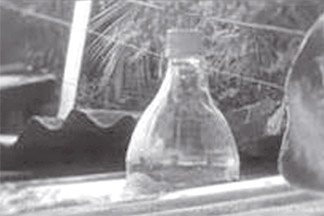
Plastic soda bottle lamp |
waste quantities, such as the population increase, urbanization and
migration of population from the rural to the urban areas leading to
much higher population densities , changes in lifestyle, and economic
activities etc. A study carried out by Bandara et al (2007) in Sri Lanka
has shown that the per capita waste generation rate is directly related
to the social status of the people.
The second issue is the change in characteristics of the waste
generated.Changes in lifestyle, introduction of cheap plastic and
polythene items such as disposable tableware, takeaway foods in
polystyrene packing and polythene lunch sheets, household electronic
items and computers, higher level of sophistication in clothing and
households leading to use of more chemical cleaners and laundry products
in plastic cans, aerosols etc., replacement of glass bottles with
plastic containers thatare not reusable, etc., have resulted in a change
in composition of the waste, with approximately 10% of the weight being
now contributed by plastics.
The average composition of waste in the municipal areas is shown in
the pie chart. There are slight variations in the composition among the
Municipal Councils and the hierarchy of local authorities, the
percentage of short term biodegradables increasing and the long term
biodegradables reducing as the level of the local Authority increases
for the Pradeshiya Sabhas, through Urban Councils to Municipal
Councils.However, in all local authorities, the major portion of waste
(40% – 66%) is short term biodegradable, as seen in the Figures below.
Even though the composition of waste shows that the major portion of
waste is short term biodegradables, giving a weight ratio of about 8
times that of plastics and polythene, with the lower density of
polythene compared to the biodegradables (A study done by Ontario Waste
Diversion Organization (2001) showed that the density ratio is about 1:
30), reverses the volume ratios to nearly 4 times plastics and
polythenes to that of biodegradables. In addition, the lower density
makes the loose plastics rise to the top when dumped, and since often
the other garbage is covered with plastic bags, we see it at the
surface.
|
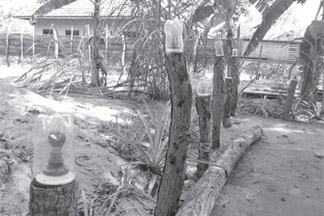 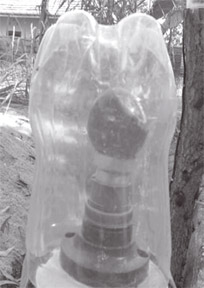
PET bottles being used as lampshades |
Our next set of issues comes from what happens to the waste if we
just allow it to remain in the environment. Unfortunately, this is what
we seem to have been doing in the past, except for a few sporadic
attempts at treatment by composting and incineration. Garbage dumped by
the roadside, water bodies and in low-lying areas became a common
sight.So what are the issues related to this poor management of solid
waste?
* Obviously, it degrades the aesthetic value of the environment, and
along with it socio-economic issues such as lowering of land values,
increase in informal
sector employment like rag-picking and scavenging and related
activities
* Health issues due to the breeding of stray cats, dogs, rats and
other vermin,mosquitoes
* Effects on wild animals that are attracted to these waste dumps,
like deer,bandicoots, and even elephants, which may cause death (due to
suffocation or consumption of plastics and toxic substances) as well as
whose feeding habits change causing changes to their immune systems and
other vital processes that may even lead to irreversible changes.
* Air pollution due to the anaerobic degradation of the biodegradable
portion resulting in emission of air pollutants like methane, ammonia,
hydrogen sulphide and other offensive gases
* Surface and ground water pollution from the leachate that seeps
through the ground or is washed off with the surface runoff during wet
weather.
* Increase in Global Warming potential due to the emission of green
house gases such as CO2, CH4 and nitrous oxide. The contribution to the
greenhouse gas budget of Sri Lanka associated with the methane released
into the atmosphere from MSW open dumps has been found to be significant
(Ramya Kumari & Bandara, 2004).
So why have we allowed our environment to be so degraded by solid
waste, and let the solid waste management issues reach such huge
proportions? Is it ignorance of the consequences? I don’t think so.
Perhaps some of the consequences like contribution to global warming
and ground and surface water pollution due to leachate may not be
obvious, and needed research and access to information beyond the common
man’s reach, but the aesthetic effects are so obvious that any person
should be able to see the effects.
Technology
There are high tech solutions, but there are many low tech solutions
too, particularly to manage at the source, so that only the portion that
we really cannot handle at source is collected for disposal.
Policies, laws and standards
The legal framework for solid waste management is quite well
established in the country. According to the Local Government Act, the
Local Authorities in Sri Lanka are responsible for collecting and
disposal of waste generated by the people within their territories. The
necessary provisions are given under the sections 129, 130 and 131 of
the Municipal Council Ordinance; the sections 118, 119 and 120 of the
Urban Council Ordinance; and sections 93 and 94 of the Pradeshiya Sabha
Act. Provincial Councils have been given the powers to manage solid
waste, as a devolved subject under the 13th Amendment to the
Constitution of Sri Lanka.
National Environmental Act
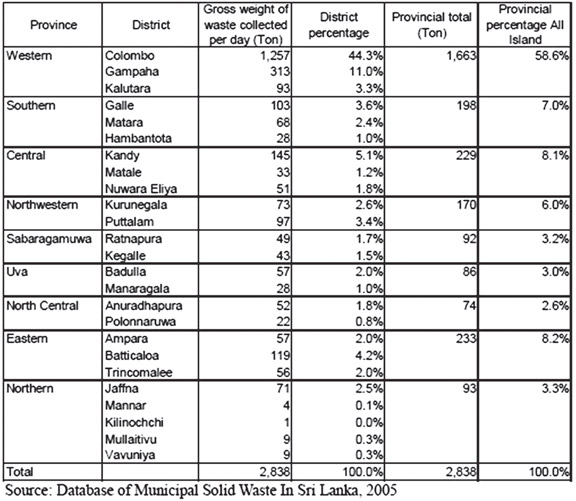 The
National Environmental Act (NEA) of 1980 which was subsequently amended
in 1988 provides the necessary legislative framework for environmental
protection in the country. The Ministry of Environment prepared the
National Strategy for Solid Waste Management in 2000, which recognized
the need for SWM from generation to final disposal through a range of
strategies, based on the 3-R principal, as well as the need for
decentralized actions as well as centralized actions such as developing
the market conditions for sale of recyclable materials and products made
from recycled materials. The
National Environmental Act (NEA) of 1980 which was subsequently amended
in 1988 provides the necessary legislative framework for environmental
protection in the country. The Ministry of Environment prepared the
National Strategy for Solid Waste Management in 2000, which recognized
the need for SWM from generation to final disposal through a range of
strategies, based on the 3-R principal, as well as the need for
decentralized actions as well as centralized actions such as developing
the market conditions for sale of recyclable materials and products made
from recycled materials.
This was superseded by a National Policy for Solid Waste Management
prepared in 2007 “to ensure integrated, economically feasible and
environmentally sound solid waste management practices for the country
at national, provincial and Local Authority level”. A major activity
that sprung from the National Policy is the setting up of the Pilisaru
Programme in 2008, to solve the solid waste problem at the national
level, with
the help of the “Pilisaru Project” at the Central Environmental
Authority, with the concept of reusing the resources available in the
collected garbage to the maximum before final disposal. While technical
and financial assistance on SWM to the local authorities is a major role
of Pilisaru, it is also empowered to take legal action against those
local Authorities that are not managing their solid waste properly.
In addition, a general guideline for the implementation of SWM was
prepared by the Central Environmental Authority in 2005, which is
available in the CEA website. The Central Environmental Authority has
stipulated regulations giving standards and criteria for generation,
collection, transport, storage, recovery, recycling, disposal or
establishment of any site or facility for the disposal of any waste
specified as ‘Scheduled Waste’, and such activities need an EPL for
operation. (Government Gazette Extraordinary No. 1534/18 - FEBRUARY 01,
2008). A specification for Compost from Municipal Solid Waste Management
and Agricultural Waste was stipulated by the Sri Lanka Standards
Institution as Sri Lanka Standard 1246: 2003 (UDC 628.477.4).
Thus we can see that lack of policies or legal provisions cannot be
cited as a major barrier for a clean and healthy environment free from
garbage dumps. Lack of funding is a factor, because the legal
responsibility of solid waste management is with the local Authorities
and the Provincial Councils, which are not profit making organizations.
Most of the local Authorities pay more attention to the improvement of
physical infrastructure coming within their purview, and their concern
toward SWM issue is low and the amount of resources utilized for SWM is
relatively low. However, within the last few years, several funding
agencies have provided financial assistance to the Ministries of
Environment, Local Government and Provincial Councils, for Solid Waste
Management
Attitude
However, I think the main reason behind the poor state of affairs
with regard to our Solid Waste Management is our attitude. We are so
used to not taking responsibility for the waste that we produce, that it
is very easy to blame the Local Authorities for not doing their job, and
absolve ourselves from the blame. If we stop for a moment to think ‘who
is actually responsible, any reasonable person would realize that we,
who produce the waste, should be held responsible for safe disposal of
it too. True enough, we are paying taxes and the local authorities are
expected to provide services, but when it comes to resource wastage, how
much can money compensate? All these heaps and mountains of garbage
contain so much of resources that should not have gone there in the
first place. This is what we should be thinking about. Not throwing good
stuff away and then trying to recover some resources from it, but not
throwing it away at all.
How can we change this?
Ideally, if we could go back to the lifestyle that we had 50 years
ago, we would be undoubtedly much better as far as sustainability goes.
However, that is unlikely to happen; but we can still keep our hopes for
a better future, because the younger generation seem to be more
conscious about the diminishing resources than ours. If we can even at
this late stage provide them with the right kind of platform, we may be
able to redeem our losses, at least to a certain extent.
Most of us are familiar with the hierarchy of actions in Solid Waste
Management.
Avoid – Do you really need it?
Reduce – How much is enough?
Reuse – Can it be used for another purpose?
Recover – At least some parts, metals, chemicals
Recycle – Don’t waste your waste – convert to usable products or
energy
Dispose safely
How can we practise these principles? We need to inculcate them in
our society. Make them our lifestyle. We have to be innovative, and
think outside the box. We Sri Lankans are quite good at improvisation
and innovations. We can see that things are moving in the right
direction, with the support of the Ministries of Environment and Local
Government, CEA, Pilisaru Programme and the Provincial Councils. Here
are two examples of what we can do with a 2 litre PET Bottle:
Example 1: A small hotel in Arugambay was reusing the PET Bottles as
lampshades in their garden.
Example 2: Plastic Soda Bottle Lamp - An improvisation to light up
dark spaces using the sunlight during the daytime. The bottle is filled
with clean water, and about 3 tablespoons of liquid bleach is added to
prevent algae growth. The bottle is tightly capped, and secured on the
roof, with a part of the bottle above the roof and the rest below the
roofing sheet.
The sunlight enters through the upper part of the bottle, gets
refracted within it, and is emitted from the lower part, diffusing light
into the dark interior of the room. This simple device is bringing
happiness to so may people living in dark, crowded shanties in the
developing world.
This is an example that we should definitely follow, as it has
multiple advantages of bringing light to dark spaces, particularly in
single storey houses,
warehouses, garages etc. utilizing sunlight, at very little initial
cost and no operating cost at all and reuses plastic that would have
needed disposal or recycling. If this idea can be propagated in the
country, it is certainly going to help reduce the cost of electricity or
kerosene used to light up homes, and would improve the living condition
of some of the underserved homes.
Thus we can see that the main issues of Solid Waste in Sri Lanka are
the very high quantities that are generated and the characteristics of
the waste, and the issues arising from what happens to the waste if we
just allow it to remain in the environment, such as aesthetic effects,
health issues, effects on wild animals, air, water and soil pollution
and increase in Global Warming potential.
Our country has adequate legislation, regulations and organizational
structure, but the main cause of the poor state of affairs seems to be
the failure of the public to take responsibility for the waste that they
generate, and not concentrating our efforts on the prevention of waste
generation and looking for alternative uses rather than throwing these
resources away.
However, there is hope for a better future because the younger
generation is much more sensitive to the environmental impacts of this
unsustainable behaviour, but we need to provide them the necessary
support. We can see that things are moving in the right direction, with
the support of the Ministries of Environment and Local Government, CEA,
Pilisaru Programme and the Provincial Councils, and some private sector
participation too.
(The writer is a
Senior Professor, Department of Civil Engineering, University of
Moratuwa) |



